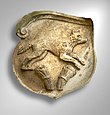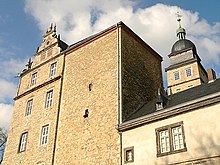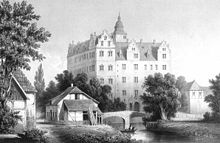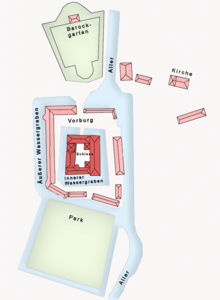Wolfsburg (castle)
| Wolfsburg Castle | ||
|---|---|---|
|
Wolfsburg Castle (south-west side) |
||
| Creation time : | First mentioned in 1302 | |
| Castle type : | Niederungsburg | |
| Conservation status: | converted into a renaissance building | |
| Standing position : | Noble | |
| Place: | Wolfsburg | |
| Geographical location | 52 ° 26 '21 " N , 10 ° 47' 58" E | |
|
|
||
The Wolfsburg is a 1302 first documented, medieval lowland and water castle , which later into a Renaissance walked -Schloss. It is located in eastern Lower Saxony in the city of Wolfsburg named after it, which it has owned since 1961.
Wolfsburg developed from a residential tower on the Aller into a moated castle with the character of a fortress. In the 17th century it became a representative, but nevertheless well-fortified castle , which represents the northeasternmost representative of the Weser Renaissance . The founders and builders were the von Bartensleben noble family . After their line died out in 1742, Wolfsburg passed by inheritance to the Counts of Schulenburg .
Surname

The castle name Wolfsburg does not indicate a wolf-rich area here on the Vorsfelder Werder , even if there were certainly wolves in the nearby Drömling wetland . The wolf, which gave the castle its name, is derived from the heraldic animal of the noble family von Bartensleben as the builder.
The city that was created here in 1938 was named after Wolfsburg Castle. At first, however, it was called Stadt des KdF-Wagen bei Fallersleben because of the industrial facilities used to build the Volkswagen . After the end of the Second World War , the city council decided on May 25, 1945 the renaming.
Building description


Structure
Since the 17th century, the castle has been a solid four-sided building that encloses an inner courtyard. Accordingly, the structure has four wings that are named after the cardinal points. The contrast to the fortress-like wall mass is formed by the upper outline of the building through filigree gables, portholes and the pointed roofs of the towers .
entrance
Larger-than-life stone knight figures adorn the castle entrance with a round arch. Above the portal there are stone shields with the Bartensleben coat of arms, envious heads and figures of knights. The portal architecture, like the terrace with a large flight of stairs to the park side, is an ingredient of the 19th century.
Keep
The keep is integrated into the building as part of the west wing and can be recognized as such by its lack of decoration and windows. The tower has a base area of 9 m × 9 m, a height of around 23 m and wall thicknesses of up to 3 m. It is the oldest part of the entire complex and its beginnings are likely to go back to the 13th century.
Towers
In the inner corner of the courtyard there are three more towers that connect the individual floors with each other as stair towers. These are the Hausmannsturm , which is the highest tower at around 30 m, the Uhlenturm and the hexagonal Wendelstein with spiral staircase . They were created in the 16th century during the conversion from a castle to a chateau.
Building wing
The north and south wings from the 16th century were mainly used for residential purposes. The approximately 25 m high east wing was completed at the beginning of the 17th century. With its splendid decorative architectural forms of the Weser Renaissance , it was a purely representative building. On the ground floor there is a 30 m long and 9 m wide hall, today's garden hall . This is followed by a smaller hall, the fireplace room and the court arbor (office). The wing still shows the remains of an arcade porch facing the inner courtyard . At roof level it is surrounded by corbels , which presumably once supported a wooden battlement. This wing of the building illustrates how the position of power of von Bartensleben was visibly expressed through architecture at the end of the 16th century . In 1935, a stone tablet with an excerpt from Psalm 91 was attached to the west wing, reminding of how Werner Graf von der Schulenburg-Wolfsburg, the four-year-old son of the castle owner at the time, fell out of a window on the first floor and was largely unharmed.
history
founding

The reason for building Wolfsburg was the fiefdom of the von Bartensleben family, which they were given in the 13th century in the area of what is now Wolfsburg. The nobles also monitored the trade routes at the Aller crossing and needed a fortification to secure their rule. The castle was first mentioned in a document in 1302 as Wluesborch . The document is issued by the four brothers Borchard, Günzel, Günter and Werner von Bartensleben . It was a ministerial family that came from the village of Bartensleben near Helmstedt. Her family members appeared in the area at this time, including in 1288 at the castle in Vorsfelde . There is also a documentary mention as early as 1135, but it is not certain whether it refers to Wolfsburg or a forerunner castle. Emperor Lothar III. equipped the newly founded Benedictine monastery at the Kaiserdom Königslutter with free float, including a Wulvosburg , which is named in the same course as the village of Käsdorf .
Middle Ages and Modern Times
During the Middle Ages , the castle was not a closed complex, but consisted of the keep and an attached part of the building, the old house in today's west wing. The complex was a fortress that was difficult to conquer and of considerable strategic importance.
Since the Bartensleben renegade their liege lord , Duke Magnus the Younger , by entering into a feudal contract with an eastern sovereign, Magnus built Neuhaus Castle in 1370–72 with the help of the city of Braunschweig as a stronghold against Wolfsburg and Vorsfelde Castle . In 1423, however, Neuhaus Castle also came to the Bartensleben ( Rothehofer line).
In the late Middle Ages the Wolfsburg was equipped with cannons, because according to a document from 1437 the number of guns should be increased by ten in the event of war. According to tradition, fighting against the castle only came about in the feud between von Bartensleben and Duke Otto von Lüneburg in 1464. Most of the castle is said to have been demolished.
Wolfsburg emerged from the Thirty Years' War as one of the few aristocratic castles undamaged. However, it was almost always occupied by warring parties, most recently by the Swedes. The rulers of Brunswick and Magdeburg achieved their withdrawal in 1650 by having the lords of the castle grind down the fortifications. Six years later, von Bartensleben had restored the fortifications because they wanted to keep the castle's military character.
In 1816 the manor district of Wolfsburg came with the castle as a Prussian exclave to the newly formed district of Gardelegen .
After the castle was sold to the city of the KdF-Wagons in 1943, the latter used the building for various purposes. In 1945 the occupying forces occupied the castle, and in 1946 they returned it to the city of Wolfsburg. In 1947 the city of Wolfsburg sold it to the state of Lower Saxony because they did not have the means to maintain the castle structurally. In 1948/49 there was a home for the severely disabled in the castle. From 1949 to 1951, a youth home supported by the Danish Red Cross was housed there, and in 1951 the German Red Cross took over . In 1952/53 the state youth welfare organization operated a facility for the training of young men in the castle. After that, from 1953 refugees from the GDR were housed in the castle, this facility was supported by the workers' welfare. After the castle was sold to the city of Wolfsburg in 1961, the various wings of the castle were renovated over the years. Since 1959 it has served artistic, cultural and representative purposes, including at times the artist group “Schloßstraße 8” - the address of the castle. In 1961 a printing workshop for artists was set up. In 1966/67 the garden hall, the court arbor and the fireplace room were completed. The Kunstverein Wolfsburg has been exhibiting contemporary art in the castle since 1967 . The Municipal Gallery was opened on October 20, 1974 . On October 12, 1980, the local history museum (now the City Museum) was opened in the basement of the east wing; it was previously located in the Goethe School in the city center . In 2000 it moved to its current location in the Remise , in October of the same year the restaurant of the same name was also opened in the Castle Remise .
After the facade renovation of the north wing, it now appears white, while the rest of the castle facade has the brown natural color of the quarry stones or a light brown color after an earlier renovation. Lime sludge was applied for the renovation , the window frames were painted anthracite. This color should come close to the former state of the castle.
Building history
Medieval castle


In the early days around 1300, Wolfsburg consisted only of a stone residential tower on the Aller, the forerunner of which could have been a wooden watchtower in the style of a lowland moth . The tower, which is around 23 m high today, later referred to as the keep , is the oldest remaining part of the current complex. It was accessible halfway up with a wooden staircase or ladder that could be pulled up in the event of enemy attacks. Initially it was probably the residential tower of von Bartensleben. In the long run it did not do justice to the aristocratic living and economic needs and as a result, further buildings and fortifications were built. Within the later castle complex, the keep served as a dungeon and prison.
Because of its location in the Allerniederung, the castle was probably surrounded by water from the very beginning. Until the 19th century they protected two moats that were fed by the nearby Aller and Hasselbach. The inner moat immediately enclosed the castle, which in connection with drawbridges made it a water castle. Around 2002 the inner moat, which was filled in in the 19th century, was archaeologically examined in several places. Remains of the wall surrounding the trench were found to a depth of 2.6 meters. After the investigations, the wall and the moat were represented on the surface by paving and gravel, so that the former course of the moat around the castle is visually visible. In addition, the moat remained open in the area of a wall corner measuring 3.5 × 3.5 meters and was covered with an accessible glass surface.
The outer moat surrounded the larger outer bailey as a refuge for the subjects in case of war. The former ditch can still be seen today as a shallow hollow. In addition, this area was secured by a wall ring with defensive rondelles, to which farm buildings and stables, today's Remisen, were later added. Investigations carried out today have shown that the castle is not, as suspected, built on wooden stakes in boggy ground. For the most part, it stands on sandy subsoil and is only partially stored on oak piles.

Weser Renaissance castle
In the middle of the 15th century, a medieval castle no longer corresponded to the status of that of Bartensleben . They converted the complex, which offered little living comfort, into a representative palace in the Renaissance style with gardens and parks. Nevertheless, the character of a fortified moated castle was retained until 1840, when the protective moats were filled in during the Aller regulation.

Due to his great fortune, Hans von Bartensleben , the Rich , began to renovate the castle in 1574. For the work he employed bricklayers, stonemasons and carpenters, for whom he paid. The farmers from the villages of the Vorsfelder Werder provided him with free labor through manual and tension service (with horse and cart) . When the Bartensleben stressed this excessively, the farmers (among others in 1600) complained to their supreme lord, Duke Heinrich Julius of Braunschweig-Wolfenbüttel . From then on, compulsory labor was set in writing to “only” ten hours in summer and eight hours in winter twice a week, not including travel times from places up to 15 km away.
Hans the Rich had a dilapidated part of the building, the Red House , demolished and the current north wing with the entrance gate of the castle built instead. When he died in 1583, his relative Günzel continued the work with his brother Günther and their uncle Jakob and built the representative east wing. After that, the south wing was built as a knight house and Palas . It was not until 1620 that the palace was completed in its current form as a four-wing complex with a closed inner courtyard measuring 50 m × 60 m.
When it was converted into a Renaissance castle, the architectural and decorative shapes were influenced by the Weser Renaissance , of which the castle is considered to be the most typical and north-eastern representative. Master builders, stonemasons and sculptors, who were also involved in the construction of palaces in the Weser region, such as the Hamelin master builder Johann Edeler (also: Johann von der Mehle) participated in the construction.
Castle Park
In the course of the conversion to a representative palace building, gardens and parks were created. The New Garden on the south side was built at the end of the 17th century. At the beginning of the 18th century, a baroque pleasure garden was laid out on the north side of the palace . It was given its current form due to extensive reconstruction work in 2000. In this context, the figurative decorations were also renewed. These are sandstone putti that are allegories of the four seasons in front of the tea pavilion. The landscape park on the east side and the large outside staircase leading to the castle were not built until the 19th century.
Ownership


Since the start of construction on Wolfsburg around 1300, the castle has belonged to the von Bartensleben family and was their mansion for centuries. The line ended with the death of the last male representative, Treasurer Gebhard Werner von Bartensleben, on January 6, 1742. He left the castle and goods to his daughter Anna Adelheit Catharina as sole heir. Since she was married to the Prussian Lieutenant General Adolph Friedrich von der Schulenburg- Beetzendorf, the Bartenslebische property and Wolfsburg passed to the noble family von der Schulenburg in 1746/47 . The castle was then the representative seat of their Wolfsburg branch for over 200 years, to which Gebhard Werner von der Schulenburg , Gebhard von der Schulenburg-Wolfsburg , Werner von der Schulenburg-Wolfsburg , Günther von der Schulenburg , Werner-Karl-Hermann Graf von der Schulenburg- Wolfsburg and Günther Graf von der Schulenburg-Wolfsburg belonged. On November 15, 1942, the last lord of the castle, Günther Graf von der Schulenburg-Wolfsburg, left the complex and moved into his newly built Neumühle Castle near Tangeln , then in the Salzwedel district . The count's family had to leave after large parts of their land had been expropriated for the construction of the Volkswagen factory and the economic livelihood of the castle had been lost. On March 19, 1943, the town of KdF-Wagen, founded in the Allertal for the production of the Volkswagen 1938, acquired the castle from the Count for 560,000 Reichsmarks . In 1947 the city, which has since been renamed Wolfsburg, offered the castle for sale with the following newspaper advertisement:
- City-owned castle for sale (Weser Renaissance). In a convenient location on the Mittelland Canal and the Hanover / Berlin railway line. Near Braunschweig. Over 80 rooms. A total of 3.88 ha…. Commercial use possible.
The complex in need of renovation thereupon acquired on August 11, 1947, the state of Lower Saxony , which wanted to get rid of the castle complex in 1961 for the same reasons. Since the Wolfsburg city administration had meanwhile become aware of the historical significance of the historical building and had greater financial leeway, it acquired Wolfsburg Castle back from the state of Lower Saxony on March 28, 1961 for 400,000 DM .
Todays use
location
Wolfsburg Castle is now part of the Alt-Wolfsburg district of which it was once the center. It is surrounded by parks, a baroque garden and half-timbered houses. Not far is the Evangelical Lutheran St. Mary's Church as the former patronage church of the castle owners, which was first mentioned as a chapel in 1434. The entire ensemble including the castle and the outer bailey now forms the traditional island of the city.
700th anniversary celebration
On June 17, 2002, a celebration of the 700th birthday took place at Wolfsburg Castle, which was first mentioned in written records in 1302. It consisted of a ceremony for invited guests, musical performances and cabaret in the baroque garden. The city museum opened its exhibition "If walls could tell ..." on the history of the castle.
use
Wolfsburg Castle is now considered the cultural center of the young city of Wolfsburg , which was not created until the Volkswagen factory was built in 1938. Accordingly, it is used as an event location and seat of cultural institutions. The numerous rooms and the inner courtyard as well as the outdoor facilities offer adequate space. The castle rooms garden hall , court arbor and fireplace room are used for representation purposes of the city of Wolfsburg. Civil weddings take place regularly in the court arbor. The castle and the former outer bailey with the castle outbuildings now house the facilities:
- Wolfsburg Castle City Museum
- City Gallery Wolfsburg
- Wolfsburg Art Association
- Heidersberger Photographic Institute
- Catering business
Annual castle events are:
- March / April: Spring country party - garden exhibition in and around the castle
- June: International summer stage - open air music spectacle in the palace courtyard
- June / July: Landpartie - garden exhibition in and around the castle
- September: Werk-Stadt-Schloss - artist project with trainees from Wolfsburg companies
- December: Advent in the castle - Advent festival in the festively decorated castle
See also
literature
- Johannes Zahlten: Wolfsburg Castle - an architectural monument of the Weser Renaissance. Braunschweig 1991, ISBN 3-925151-52-4 .
- Martin Fimpel: Wolfsburg Castle 1302–1945. In: Lower Saxony Yearbook for State History. Volume 75, Hannover 2003, pp. 127-159. ( Online , 62.5 MB)
- Martin Fimpel: Lurking for vassal death. The end of the Lords of Bartensleben at Wolfsburg Castle. In: Braunschweigisches Jahrbuch für Landesgeschichte. Volume 85, Hannover 2004, pp. 101-118.
- Martin Fimpel: Wolfsburg as a rural society of nobility and farmers. in: Christoph Stölzl: The Wolfsburg Saga. Stuttgart 2008, pp. 20-31.
- Wolfsburg Castle - history and culture. City of Wolfsburg, Wolfsburg 2002, ISBN 3-930292-62-9 .
- Historical and regional excursion map of Lower Saxony, sheet Wolfsburg. P. 145, publications by the Institute for Historical Research at the University of Göttingen, Hildesheim 1977, ISBN 3-7848-3626-7 .
- Hans Adolf Schultz : Castles and palaces of the Braunschweiger Land. Braunschweig 1980, ISBN 3-87884-012-8 .
- Hans Adolf Schultz: Castles, palaces and mansions in the Gifhorn-Wolfsburg area , Gifhorn, 1985
- Ernst Andreas Friedrich : The castles of Wolfsburg , pp. 136-138, in: If stones could talk , Volume III, Landbuch-Verlag, Hanover 1995, ISBN 3-7842-0515-1 .
- Andreas Wallbrecht: Old moated castle in new splendor in: Archeology in Lower Saxony , 2002
Web links
- Entry by Christian Frey zu Wolfsburg in the scientific database " EBIDAT " of the European Castle Institute
- Wolfsburg Castle in the Lower Saxony Monument Atlas
- Photo series from the castle 2002–2005 with floor plan, baroque garden, park, garden exhibitions among others
- Building description and photos at "Region Braunschweig-Ostfalen"
- Description at wolfsburg.de
- Wolfsburg "City Museum in the Castle"
- Description and photos in burgerbe weblog
- Panorama photo of the castle courtyard
- Aerial photos of Wolfsburg Castle ( Memento from October 21, 2013 in the Internet Archive )
- Reconstruction drawing of a moated castle by Wolfgang Braun
Individual evidence
- ↑ Eva-Maria Bast: The fall of little Werner. In: Wolfsburger Nachrichten. Friday Packet for November 20, 2017.
- ↑ Eberhard Rohde: Psalm words on old castle walls. In: Wolfsburger Nachrichten. Edition of August 4, 2018.
- ^ Willi Schulz: Wolfsburg, center of a changing landscape. Wolfsburg 1969. p. 83.
- ^ Wolfsburg, the Volkswagen city. Publishing house looking and knowing. 1st edition, Bad Pyrmont 1954. p. 16.
- ^ Sylvia Telge: The artists of "Schlossstrasse 8". waz-online.de of November 22, 2017, accessed on March 25, 2018
- ^ Exhibition of the Städtische Galerie zur Druckgrafik , staedtische-galerie-wolfsburg.de, accessed on March 25, 2018
- ↑ Surprise: Wolfsburg Castle is now snow-white. Wolfsburger Nachrichten of May 3, 2014, accessed on June 13, 2014
- ^ Andreas Wallbrecht: Old moated castle in new splendor. In: Archeology in Lower Saxony. 2002, pp. 116-119.
- ↑ 80 years of Wolfsburg. In: Wolfsburger Nachrichten. Wolfsburg 2018.







